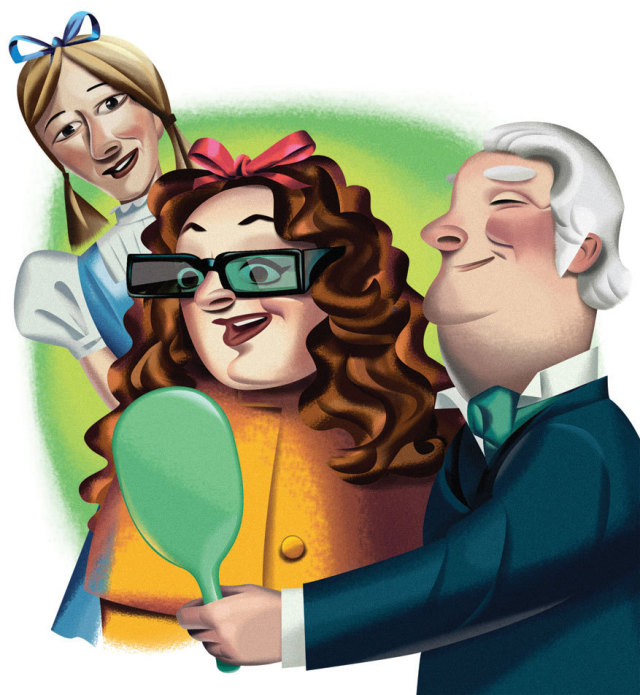The Vision Thing

SHE STOOD WAITING on Pike Street, huddled against a battering winter gust. “You look great,” I told her. “No, I don’t,” she said mordantly. “But maybe I’m about to.” Truth was my friend did look great, compared with how she’d looked three weeks before. That’s when her husband came home from work and picked the kind of fight that permanently alters the landscape of a marriage. The kind where things come out that change everything. He was an emotional bully. She knew it from about day three of the honeymoon. Still, she could never quite summon the force to boot the guy. A lifetime of accommodation dies hard, and she had resigned herself to accommodating him for the sake of their daughters.
She did seem to be longing for some kind of fresh start, however. “Could you come glasses shopping with me?” she’d blurted, as if something hugely important suddenly depended on new frames. “There’s this guy on Pike. He just finds the right glasses for people. I’ve been hearing about him for years. People call him the Wizard of Eyes.”
So there we stood outside Broadway Vision Source (which, as incongruity would have it, is on Pike). And there was the Wizard: a pink man with a round face and a kind smile. “Well, you are plainly a Winter,” he declared. “Let’s start with the jewel tones, shall we?”
Thirty-some years ago, Warren Ruby was an ordinary eyeglasses salesman who saw frames in the ordinary way. Then, in 1978, Ruby attended seminars held by the Helena Rubenstein makeup studio, training eyewear professionals to match glasses to facial coloring. It opened Ruby’s eyes.
Suddenly he saw why he, the son of a red-headed Irishman, couldn’t go near pink. Why the skin around his wife’s eyes looked bruised when she wore yellow. Why so few Asians could pull off tortoiseshell.
Years before Color Me Beautiful would definitively split the human race into Winters, Summers, Springs, and Falls, Ruby began teaching his sales team to look around the mouth and under the eyes for the truest tonal feedback. He was color-draping—placing swaths of fabric near faces to uncover the best complements—women and men, decades before the invention of metrosexuals.
“I discovered that eyeglasses weren’t just tools to help people see,” Ruby told us. “Eyeglasses help people be seen.”
My friend turned toward us, having traded her nondescript oval wire frames for a pair of emerald-green aviators. “Oh dear,” Ruby lamented. “I’m afraid those will arrive at the party about an hour before you do.” He held out delicate deep-red frames with rimless bottoms for her to try. “Mmmm…sweet,” he mused, standing back for the whole picture. “Look at the shape of the face in these. These work. What we’re trying to do here is find your Oil of Olay lady.”
{page break}
My friend shot me a nervous look. “The Oil of Olay lady,” Ruby explained, “had the perfect oval face. Remember? What the right pair of glasses will do is bring the oval out in your facial shape.” He put a pair of black Drew Carey specs on himself. “Look at these—all wrong. They make my round face even rounder. But these,” he said, donning a pair of rectangular frames, “these work, don’t they?” For this reason, heart-shaped faces should never wear cat eyes. Square jawlines should run screaming from flat-bottomed frames.
So second-nature is all this for Ruby, he once forgot himself entirely and approached a stranger in New York City, arms outstretched, fully intending to remove his glasses. “I was just going to tell him that his glasses made him look like a basset hound,” Ruby told us. “He wasn’t happy.”
Still, he said, some looks are designed for purposes profounder than face shape. He keeps one business dandy in town supplied with round frames in spite of the fact that his face would look a hundred times better in angular. (Like the bartender who remembers everyone’s “usual,” Ruby remembers every face he’s ever fit for frames.) It’s his style expression, his signature. “Oh, it’s completely wrong,” Ruby quipped. “But somewhere along the line he decided that it’s him.”
My friend twirled around, radiant in a pair of eggplant frames with slightly upturned edges. “Okay, okay!” Ruby enthused. “Very good! Purple is all about art, color, interest. These are edgy. These are powerful. Plus they’re great on you.”
She tried on the red again, then the purple, then back and forth in a toggle of indecision. “Take some time, think about it,” the Wizard counseled. “But here’s the thing to remember: The red ones say sweet. The purple ones say strong. It depends on who you want to be.”
She was quiet all the way down Pike Street. “Do you buy that?” she finally asked. “They’re just glasses.” I shrugged, reminding her of the story Ruby told of the girl he took for a high schooler, who came to him in search of a bolder image. When he steered her into a pair of thick rectangular black frames, the clear “don’t mess with me” look helped the young miss be taken seriously as the prosecuting attorney she actually was.
A few months later she stopped back to report that the glasses had entirely rewritten her professional life. Judges and attorneys who had dismissed her before now visibly accorded her new gravitas. “It’s all about the eyes,” Ruby marveled. “When people are trying to size you up—they go right to the eyes.”
My friend called a couple of weeks later. “I’ve made my decision,” she announced. “Can I come over?” She arrived at my door looking weary but triumphant. “I kicked him out,” she breathed, eyes closed. “I finally kicked him out.”
I gasped. “I thought you meant your glasses decision!”
“Oh, I thought I told you. I decided that right away.” And out of a shiny new case she pulled her new pair of purple glasses. I could have guessed.




